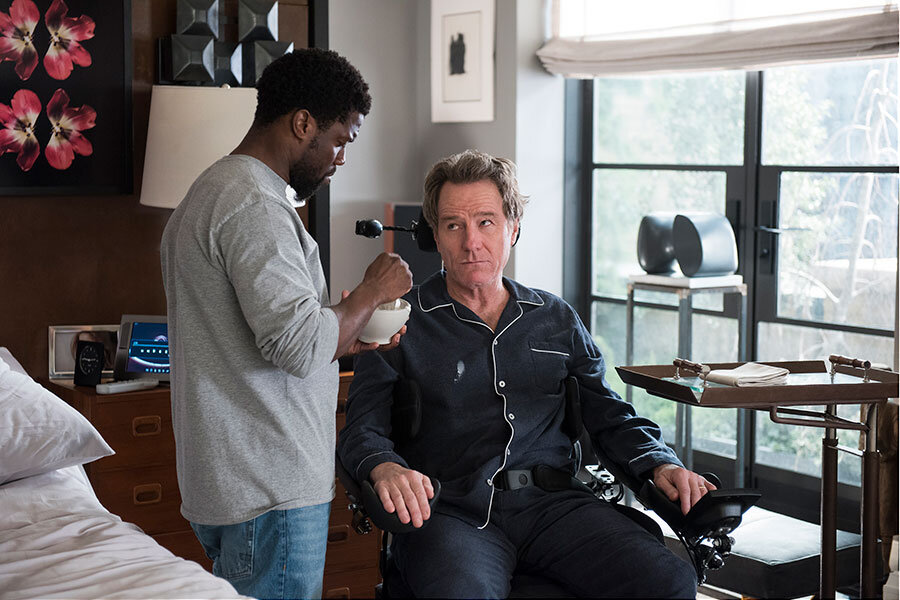In ‘The Upside,’ a predictable story yields laughs
Loading...
The opening credits for “The Upside” say it was “inspired by” a true story, but its real inspiration is the 2011 Gallic hit “The Intouchables,” one of the most lucrative French films ever made. That film, too, had its loose connection to real events. In the case of both films, though, it’s pretty clear that the real inspiration is audience-pleasing expediency.
In “The Upside,” Bryan Cranston plays Phil, a billionaire investor and author who is quadriplegic following a paragliding accident. Also grieving the death of his wife, he has no desire to live out his life, despite the upbeat urgencies of his executive assistant, Yvonne (Nicole Kidman, underserved in an underwritten role), who has been interviewing potential caregivers. The least capable, Dell (Kevin Hart), ends up with the job. Dell is a deadbeat dad and recently paroled ex-convict who went on the job interview only to satisfy his parole board, never thinking (or hoping) he’d get the position. That he is eminently unqualified is, for Phil, perhaps his greatest qualification: He thinks that if he is proved to be beyond the reach of care, he can be left to die in peace.
Of course, we know how this will play out. The opening sequence, from which the film flashes back, where the two men are joyriding in a car as the police chase them, is a not-too-subtle giveaway. The movie’s predictability is a key to its appeal, in much the same way that the jaunty playing-out of racial stereotypes was integral to the appeal of “Green Book,” the most recent example of a movie that rejiggered the “Driving Miss Daisy” formula for a brotherhood-of-man vibe.
Phil’s Scrooge-like veneer exists only to dissipate; Dell’s con artist ways camouflage a basic decency. We are made to feel that Phil’s predicament is somehow comparable to Dell’s – that each suffers from physical and emotional neglect. Phil deeply misses his wife; Dell wants to reconnect with the young son who rejects him. Dell’s deprivation is supposed to give him special insight into Phil’s. In a key scene, he sharply criticizes a food vendor for asking him, rather than Phil, about his order, thereby rendering Phil, in effect, a nonperson.
Director Neil Burger and screenwriter Jon Hartmere pile on these life lessons, as if the film’s messaging wasn’t already clear to us. They also indulge in some semi-
objectionable stereotyping. Dell, for example, accompanies Phil to the fancy-dress opening night of “The Magic Flute,” where he initially scoffs at the operatic proceedings but then, voila, is entranced. Another time, he evinces a talent for painting that is meant to show he isn’t just a late-blooming good guy; he’s also an artist (as if we needed that extra twirl to take him seriously). The kicker is that Phil sells one of his canvases to a snooty, racist neighbor in his co-op who doesn’t realize it was rendered by Dell.
As was also true of “Green Book,” though that film had a better script and meatier acting, “The Upside” somehow overrides its own flaws because of the two lead performances. I was dreading seeing Hart do his jabbery shtick in this soppy setting, but he tones down his trademark mannerisms here. He can’t quite overcome some ill-advised comedy setups, such as the one in which he messes up Phil’s catheter, but he’s not just playing the part for laughs. And when he does, as in the scene where he first takes a shower in Phil’s luxury bathroom and can’t understand how to work the voice-operated
controls, spoken in German, the laughs do come.
Given the fact that, for almost the entire performance, Cranston can only move his neck, he is remarkably forceful. It helps that his face, his cranium, are so formidable. There’s a lot going on in his eyes. Even a scene that should by all rights be shameless, like the one in which he screws up the courage to meet an internet date (Julianna Margulies) for lunch, is effective because of how Cranston plays out its inevitable denouement. Like “Green Book,” like “The Intouchables,” “The Upside” is a movie that somehow works, at least some of the time, even when it shouldn’t. Grade: B- (Rated PG-13 for suggestive content and drug use.)







